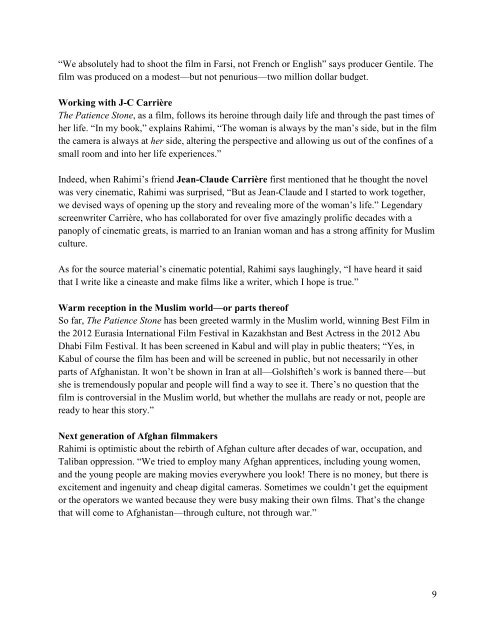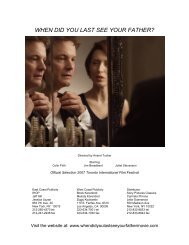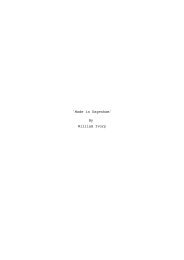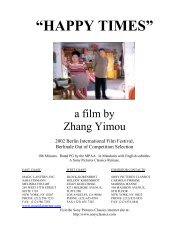Press Kit - Sony Pictures Classics
Press Kit - Sony Pictures Classics
Press Kit - Sony Pictures Classics
Create successful ePaper yourself
Turn your PDF publications into a flip-book with our unique Google optimized e-Paper software.
“We absolutely had to shoot the film in Farsi, not French or English” says producer Gentile. The<br />
film was produced on a modest—but not penurious—two million dollar budget.<br />
Working with J-C Carrière<br />
The Patience Stone, as a film, follows its heroine through daily life and through the past times of<br />
her life. “In my book,” explains Rahimi, “The woman is always by the man’s side, but in the film<br />
the camera is always at her side, altering the perspective and allowing us out of the confines of a<br />
small room and into her life experiences.”<br />
Indeed, when Rahimi’s friend Jean-Claude Carrière first mentioned that he thought the novel<br />
was very cinematic, Rahimi was surprised, “But as Jean-Claude and I started to work together,<br />
we devised ways of opening up the story and revealing more of the woman’s life.” Legendary<br />
screenwriter Carrière, who has collaborated for over five amazingly prolific decades with a<br />
panoply of cinematic greats, is married to an Iranian woman and has a strong affinity for Muslim<br />
culture.<br />
As for the source material’s cinematic potential, Rahimi says laughingly, “I have heard it said<br />
that I write like a cineaste and make films like a writer, which I hope is true.”<br />
Warm reception in the Muslim world—or parts thereof<br />
So far, The Patience Stone has been greeted warmly in the Muslim world, winning Best Film in<br />
the 2012 Eurasia International Film Festival in Kazakhstan and Best Actress in the 2012 Abu<br />
Dhabi Film Festival. It has been screened in Kabul and will play in public theaters; “Yes, in<br />
Kabul of course the film has been and will be screened in public, but not necessarily in other<br />
parts of Afghanistan. It won’t be shown in Iran at all—Golshifteh’s work is banned there—but<br />
she is tremendously popular and people will find a way to see it. There’s no question that the<br />
film is controversial in the Muslim world, but whether the mullahs are ready or not, people are<br />
ready to hear this story.”<br />
Next generation of Afghan filmmakers<br />
Rahimi is optimistic about the rebirth of Afghan culture after decades of war, occupation, and<br />
Taliban oppression. “We tried to employ many Afghan apprentices, including young women,<br />
and the young people are making movies everywhere you look! There is no money, but there is<br />
excitement and ingenuity and cheap digital cameras. Sometimes we couldn’t get the equipment<br />
or the operators we wanted because they were busy making their own films. That’s the change<br />
that will come to Afghanistan—through culture, not through war.”<br />
9
















